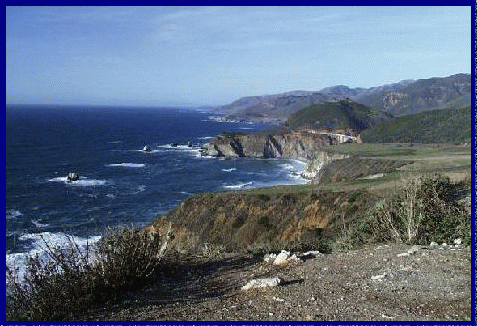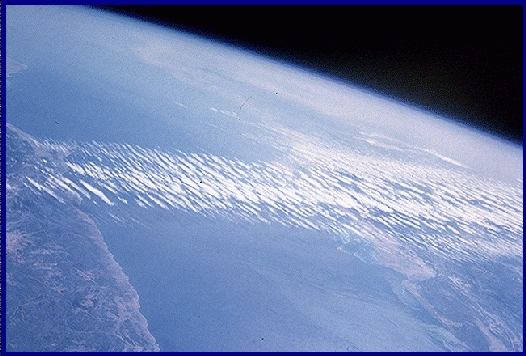 Lesson 2:
Lesson 2:
 Earth
Earth
 Planet of Life
Planet of Life
|
 2.0
2.0
 Introduction and Overview
Introduction and Overview
The third planet from the Sun is our home. We call it "Earth" even though it is mainly
covered by water. Planet "Ocean" might have been more appropriate, but we are
creatures of the land and rarely spend time in or on the water. In fact, etymologically
"Earth" means the "home farm" (cf. arable land), and we should think of it as the
"home planet."

|
Big Sur
Courtesy of

|
The single most important thing about Earth is that it has Life, and the single most important
thing about Life is that all its forms are interrelated, which means, in a sense, that there
is only one kind of life. Thus, not only is Earth (so far) our only documented example of a
planet with life, but also Life on Earth only gives us one type of life form to contemplate,
one that has cells and uses DNA for instructions for making more cells. However, except for
this basic similarity in building plan, Life on Earth is extremely diverse in its manifestations.
Among the larger organisms, it includes such different forms as trees, whales, and giant fungi.
Among the smallest, there are an incredible variety of single-celled organisms that
pervade practically all available habitats on the surface of Earth, and to at least three and
a half kilometer below Earth's solid surface. The presence of Life on Earth is evident in the
composition of the rocks making up the crust of the planet, the composition of the water
of the ocean, and the atmosphere. Life is intimately involved in the processes shaping the
face of the planet, especially in weathering and soil formation and in the making of
sedimentary rocks.
It is also intimately involved in producing the climate on Earth,
through control of greenhouse gases. Thus, the fact that Earth has Life makes it into a
planet that is quite different, in its physical state and appearance, from what it would be
without Life. Earth is the planet that Life shaped. This insight is not the same as ascribing
life to Earth itself, as in the animistic religions and their derivations. In many, perhaps
all, such religions Earth is seen as a female being bearing offspring (sometimes with the
sky, or thunderstorm, as the male counterpart). The female principle of fertility is commonly
personalized, and represented as a goddess. Such goddesses are "Erda" (Germanic) and
"Gaia" (Greek) whose names we recognize in "Earth" and "Geology".
The insight that Life
shapes Earth is relatively recent, and goes back to the German ecologist and geologist C. G.
Ehrenberg, the Russian geochemist V. I. Vernadsky, and the American ecologist G. Evelyn
Hutchinson. Ehrenberg (1795-1876), who studied the fossil remains of microscopic organisms,
realized that entire mountains are made of such remains: limestone is a result of life
processes. Vernadsky (1863-1945) explored the geochemical cycling for the major elements on
the surface of Earth. He realized that life processes are intimately involved in determining
the nature of these cycles. Hutchinson (1903-1991) studied the physical and biological in
lakes, and had a special interest in the phosphorus cycle. He emphasized that the geochemistry
of elements used by organisms (carbon, oxygen, nitrogen, phosphorus) depends entirely on
life processes.
 |
|
Source: Johnson Spaceflight Center/NASA
|
In particular, he stated that the atmosphere (both oxygen and nitrogen) is
the product of life processes involving photosynthesis, the fixing of nitrogen into organic matter,
and the release of nitrogen in the bacterial decay of organic matter.These various ideas are
These various ideas are fundamental to the scientific discipline of "biogeochemistry." The
"Gaia hypothesis" proposed by the British engineer and science writer James Lovelock (born 1919)
builds on these ideas. The hypothesis stipulates that life processes help maintain an environment
on the surface of the planet that is favorable to the continued existence of life. Given that life
processes are important in governing geochemistry and climate, and given that life has persisted
and flourished through billions of years, the hypothesis seems secure from being ever disproved.
|





















